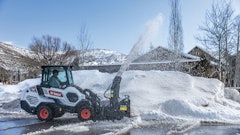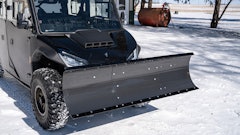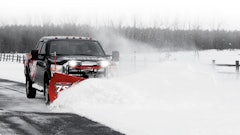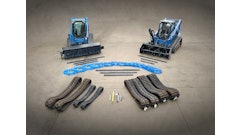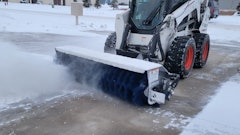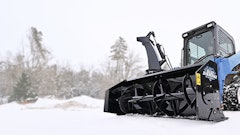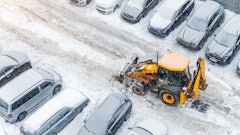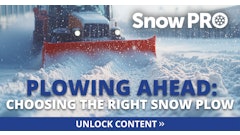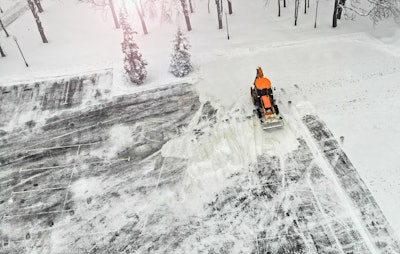
When winter weather hits, having the right snow removal attachment can make all the difference in productivity and performance. But with so many options — plows, blades, pushers, blowers, and brooms — it’s essential to understand which tool works best for which job. Choosing the wrong one can lead to wasted time, equipment strain or poor results.
Here’s a look at some common snow tools, including when to use them, when not to, and how to get the most from each.
Snow Plows: Tried-and-True Utility
- Best for: Roadways, parking lots, long drives
- Pros: Fast clearing speed, simple straight-forward operation, effective in moderate snow
- Cons: Less precise than blades, limited control in tight areas
Snow plows are a staple for general-purpose clearing on roads and large open areas. These tools are often mounted to trucks or larger utility vehicles and can cover a lot of ground quickly. They're great for long, straight passes, especially when speed matters.
However, plows are less maneuverable and not ideal for precision work around curbs, corners or tight areas. Operators may struggle with snow backfill in areas that require careful edge cleanup. When used without appropriate ballast or machine compatibility, plows can also cause traction or visibility issues in icy conditions.
Snow Blades and V-Blades: Built for Control
- Best for: Sidewalks, driveways, parking areas with obstacles
- Pros: Excellent maneuverability, hydraulic angling for directional control, versatile for varied snow conditions
- Cons: Less efficient for deep snow or wide-open areas; requires hydraulic hookups
Straight blades offer a reliable solution for general snow clearing. V-blades go further, allowing operators to switch between straight, scoop and V configurations to adapt to different snow depths and patterns.
However, these tools are sometimes over-applied in wide-open areas where pushers or blowers would be faster. Blades can also dig into uneven surfaces if not operated carefully, leading to premature wear or surface damage.
Snow Pushers: Move Big Volumes Fast
- Best for: Large, open spaces like parking lots and farmyard
- Pros: High-efficiency snow movement, no hydraulics needed, simple operation
- Cons: Limited maneuverability, not ideal for tight areas or near structures
Snow pushers are unmatched for clearing large amounts of snow quickly. They’re straightforward — just attach and push. Some models include pull-back edges for added versatility, but overall, they lack the finesse needed for work near loading docks, narrow paths or buildings.
However, their simplicity comes with trade-offs. Snow pushers are less maneuverable and not suited for spaces with tight corners or obstructions. When used in confined areas or near buildings, they often leave snow behind, requiring additional cleanup with a more precise tool like a blade or broom.
Snow Blowers: Clear It and Throw It
- Best for: Driveways, narrow walkways, and areas where snow must be relocated
- Pros: Clears snow completely from the area, adjustable throw distance, good for heavy accumulation
- Cons: Requires hydraulic power and operator skill, slower than pushers on wide-open terrain
Snow blowers shine when space is limited and snow can't be stacked nearby. Their ability to throw snow long distances — often 20 ft. or more — makes them a critical tool for operators working in densely packed or enclosed spaces. These attachments are highly effective in regions that experience consistent, heavy snowfall.
That said, blowers are slower than pushers on large, open terrain and require more technical operation. They also demand more from the carrier’s hydraulic system, or PTO output in the case of compact tractors, which can limit their use on smaller machines. Choosing a blower without verifying your equipment’s flow, pressure specs and PTO hp is a common mistake that leads to poor performance or costly downtime.
Angle Brooms: Perfect for Light Snow and Cleanup
- Best for: Light snowfalls, sidewalks, paved or decorative surfaces
- Pros: Low impact on surfaces, great visibility, ideal for final cleanup
- Cons: Ineffective for deep or wet snow, bristle wear requires upkeep
Angle brooms are designed for light-duty work and precision cleanup. They’re excellent for clearing paths without damaging the surface underneath.
However, they’re sometimes used beyond their capabilities, like trying to remove heavy snow or slush, which can wear down bristles quickly and overload the broom’s drive system. Use them as a finishing tool or for fresh snow dustings, not for primary snow clearing in harsh conditions.
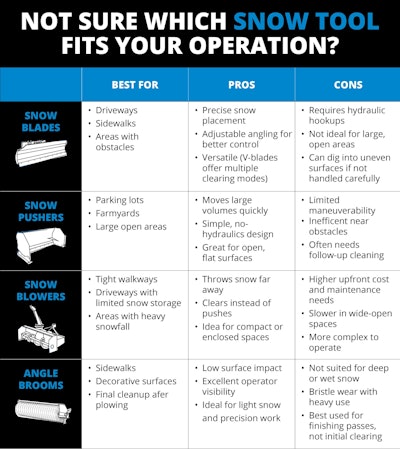
The Right Tool Makes All the Difference
No single attachment fits every snow scenario. Selecting the right snow removal tool means considering your space, snow type, and equipment limitations. Plows offer fast, straight-line clearing. Blades bring precision. Pushers move big volumes fast. Blowers handle the heavy stuff. Brooms finish the job with finesse.
To ensure you're outfitted for success this winter, talk to your equipment dealer or attachment manufacturer. They can help evaluate your needs, review your carrier specs and recommend the ideal setup for safe, efficient snow removal all season long.
Remember, talk to your dealer or equipment manufacturer to match your machine and site with the right attachment for a productive, stress-free winter.
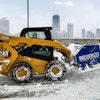
![Kubota Snow ah3 Sgv25ua[1]](https://img.greenindustrypros.com/mindful/acbm/workspaces/default/uploads/2025/10/kubota-snowah3sgv25ua1.bAUoUSziui.png?auto=format%2Ccompress&bg=fff&fill-color=fff&fit=fill&h=100&q=70&w=100)
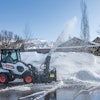
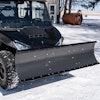
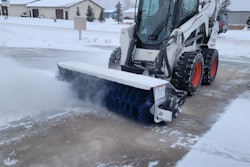

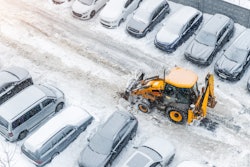
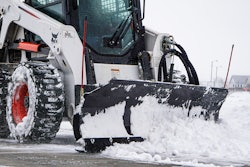
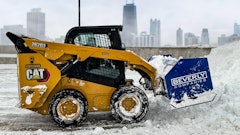
![Kubota Snow ah3 Sgv25ua[1]](https://img.greenindustrypros.com/mindful/acbm/workspaces/default/uploads/2025/10/kubota-snowah3sgv25ua1.bAUoUSziui.png?ar=16%3A9&auto=format%2Ccompress&bg=fff&fill-color=fff&fit=fill&h=135&q=70&w=240)
